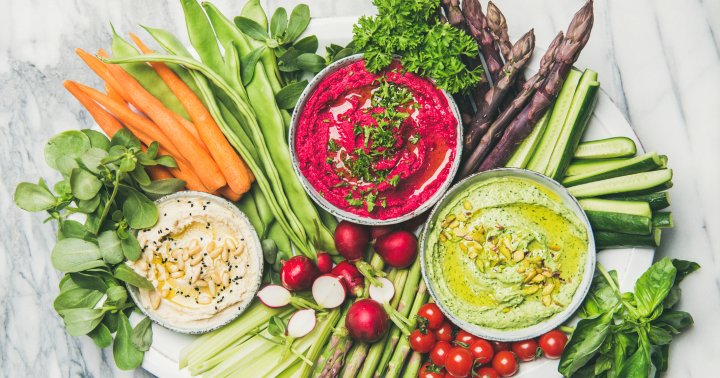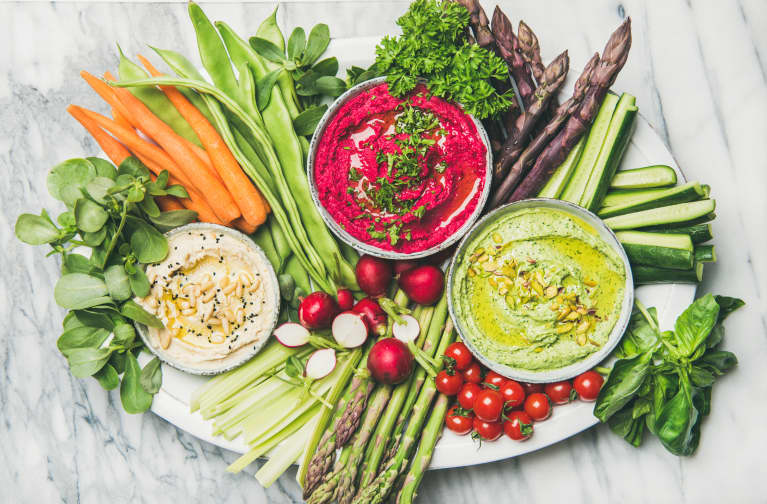For The Record, Here's How Many Servings Of Vegetables You *Actually* Need Daily
Everything you need to know about the magic number.


Our editors have independently chosen the products listed on this page. If you purchase something mentioned in this article, we may earn a small commission.
Since you were young, you’ve likely been reminded to “eat your fruits and vegetables.” When I was growing up, my parents wouldn’t let me have dessert until I had a serving of fruit beforehand. And it’s true, fruits and vegetables are some of the most nutrient-dense foods you can include in your diet, providing an array of vitamins, and minerals, and phytonutrients to fuel various health-supporting pathways and functions from within.
But it’s often difficult to discern just how many veggies you should be eating each day to meet your nutritional needs and charge your body with all the great benefits we’ve been told about for years. To set the record straight, we determined once and for all what the ideal serving of veggies per day looks like, and why you may want to maintain some healthy variety in your choices.
How many servings of vegetables do we really need per day?
Much like many of the other macronutrient, micronutrient, and food group requirements, vegetable needs and intake recommendations depend on both your age and gender. According to the U.S. Department of Agriculture (USDA), women ages 19 to 32 should be consuming 2.5 to 3 cups of veggies each day while women of any older age can stick with 2 to 3. For men, 3 to 4 cups is recommended, but for men of 60 or older, 2.5 to 3.5 is suggested.
As dietitian and mbg's vice president of scientific affairs, Ashley Jordan Ferira, Ph.D., RDN explains: "These are broad recommendations to hit (that we're seriously failing to hit as a nation), and exceeding them is not only OK, it's likely beneficial given the myriad nutrient-dense properties and health benefits of vegetables!"
What about when you fold in the fruit portions? In general, national guidelines indicate most people should be consuming 5 to 13 servings of fruits and vegetables each day. This breaks down to about two different vegetables and three fruits.
But as Ferira explains, these are helpful approximations. She shares, "every individual's unique physiological makeup and needs, plus their personalized dietary patterns and cultural preferences, will shape their actual fruit and vegetables needs and selections on a personal level."
What does a serving size look like?
Great question. Serving sizes vary depending on your vegetable of choice, and from canned to juiced to raw it can be helpful to know what classifies a serving.
According to the American Heart Association (AHA) in order to get the proper volume of leafy greens you should be eating one cup each day. Generally speaking, fresh, frozen, or canned vegetables require about a half a cup, and raw vegetable juice also requires half a cup to be considered a serving. This AHA infographic provides some useful visual cues to hone your veggie portions with more accuracy.
Cruciferous vegetables can be more difficult to determine as you can’t necessarily imagine packing a head of cauliflower or broccoli into a half cup, so the AHA explains that five to eight florets can be counted as a serving. As for carrots, one raw carrot or eight baby carrots will count towards you five a day, and half of a bell pepper will work towards that total as well.
Ferira shares that the "Academy of Nutrition and Dietetics is also a useful resource for portion sizes, too, and they make an important distinction between serving size and portion size. The Academy even dishes out child-friendly portion guidance."
Looking to complement a nutrient-dense diet with a fruit and veggie supplement? Ferira calls this approach both "synergistic and incremental, as it allows you to incorporate more micronutrients, phytonutrients, fiber, and other bioactives into your nutritional life." She goes on to say that, "this, of course, totally depends on the quality of supplement you're adding into your regimen, so choose wisely."
Speaking of smart supplement formulas, mbg’s organic veggies+ is a premium, USDA certified organic blend that delivers 31 powerhouse active ingredients (and zero "other ingredients"). In just one tablespoon, this vegan powder delivers a blend of 18 different organic fruits and vegetables such as organic carrot, broccoli, green cabbage, spinach, berries, and loads more. Did we mention the herbs, prebiotic fibers, digestive enzymes, and probiotic strains? (Like we said, 31 active ingredients).
On top of your daily consumption of veggies, Ferira says "organic veggies+ is like your 'extra credit' nutritional strategy to elevate your intake of plant nutrition and goodness daily, plus deliver fiber for digestion, gut health, and detoxification within the body."*
What counts as a serving?
Outside of the raw vegetables it can be difficult to determine what else is classified as a serving, but things like juices and canned veggies can, in fact, count towards your daily intake. “I tend to encourage getting your vegetables more from whole sources, but if you’re on the go and having a hard time sitting down for a meal, juice can have its place,” notes registered dietitian Jessica Cording, M.S., R.D., CDN. “If you’re liquifying or pureeing veggies, I recommend putting them in a smoothie so you’re getting protein and fat to stabilize your blood sugar, as well.”
Depending on your dietary pattern and health status, even potatoes and starchy veggies can have their place, with one half of a potato falling into the category of a serving of veggies. You may not want to count a side of fries, though, due to the deep frying process it takes to get them to their crunchy and delicious final form, but cooking potatoes at home with olive oil or avocado oil can be a great addition to diversify your diet.
Nutrition scientist Ferira says she prefers "potato varieties saturated with color, like sweet potatoes and purple potatoes." She explains that, in addition to these starchy veggies being more "full of flavor," the "darker varieties of potatoes generally deliver more fiber and slightly lower glycemic index impact on blood sugar than their white potato counterparts. Not to mention, they are more flavorful."
Which vegetables and preparations are healthiest?
Infusing variety in your diet is essential not only for reducing boredom within your meals, but also because each vegetable offers a unique array of nutrients that are paramount for supporting whole body health, but also for specifically improving gut health. “When we’re looking at the gut microbiome it’s thought that having a diversity of plant foods in our diet is helpful because if we’re eating the same things all the time, while we may be checking off the boxes in terms of fiber, etc., we may be missing out on other essential nutrients,” explains Cording.
Ferira further explains that vegetable variety delivers a phytochemical advantage because, "each plant boasts a unique signature of phytonutrients," she says. "Think of it like a fingerprint. A carrot will deliver a unique fingerprint of nutritional compounds, properties, and health benefits, while beets, broccoli, kale, seaweed (a sea veggie), and my personal favorite—okra—will provide you will a totally different set of nutritional power," Ferira shares, caveating that, "okra is technically a fruit because of its seeds, but we leverage it like a veggie in the culinary world." OK, we'll let it slide (but no to okra slime).
Eating a range of different veggies with varying preparation methods will also impact the nutritional value of your meal. “I always tell people to vary the way you prepare foods not only for their nutritional impact but also from a taste standpoint,” explains Amy Kimberlain, RDN, CDCES, Academy media spokesperson. For example, tomatoes contain more lycopene when cooked in comparison to raw. Lycopene is a carotenoid, one of those powerful phytonutrients Ferira was referring to before.
“Try to keep the cooking time, temperature, and amount of liquid to a minimum. Steaming is one of the best ways to cook most vegetables versus boiling—boiling causes water-soluble vitamins (like vitamin C, thiamin, and folate) to leach into the water,” adds Kimberlain.
All vegetables ultimately offer some benefit to your body, but at the top of the list are leafy greens which provide a significant impact on longevity. In fact, one study revealed that consuming one serving of leafy greens such as kale, spinach and collards each day have shown to support cognitive function, and our brain health is critical for longevity.
(For a nutrition Ph.D. philosophy and approach to longevity nutrition and how to eat for health span, check this out).
Vegetables are an essential part of any healthy diet, and getting enough of them will not only fuel your body (and gut microbes!) with fiber, but their unique signatures of vitamins, minerals, and phytonutrients also deliver major health benefits and help you feel your best.
Start with squeezing a vegetable into every meal (omelets and delicious smoothies are an easy way to do this in the morning) and you’ll reap all the wonderful benefits while bulking up your diet.
If you are pregnant, breastfeeding, or taking medications, consult with your doctor before starting a supplement routine. It is always optimal to consult with a health care provider when considering what supplements are right for you.

 AbJimroe
AbJimroe 
































